Overview over my Vintage-PCs
Here is a list of PCs with old hardware I assembled. The use is for capturing old games and demoscene productions from real hardware. The systems are also used as working game PCs at events such as the yearly Long Night Of Computer Games in Leipzig. The pictures may not be up to date regarding the component tables as systems get changed sometimes.| 486DLC system | |
| CPU | Cyrix 486DLC-40 (1 kB L1 cache) with IIT 4C87DLC-40 |
| Mainboard | SiS 386 mainboard |
| RAM | 8x 4 MB SIMM 30pin |
| Graphics |
TSENG ET4000 with 1 MB and Truecolor DAC 80 MHz connected with VESA to #9 GXiTC Number Nine GXiTC with Acumos2 VGA part 512 kB and TIGA with 4 MB framebuffer and 1 MB instruction RAM, 135 MHz DAC. |
| Network | 3Com Etherlink III 10 MBit/s |
| Sound |
Primax AltraSound (identical to GUS CD3) with 1 MB Terratec EWS64S with 18 MB |
| Storage |
Multi I/O controller from Acer with M5105 3.5" and 5.25" HD disk drive Quantum Lightning 540A - 520 MB Sony CDU-33A double speed drive on own controller card serial/parallel ports with 16450 UART |
| Other |
Seventeam ST-221WHT AT power supply Lintec desktop case |







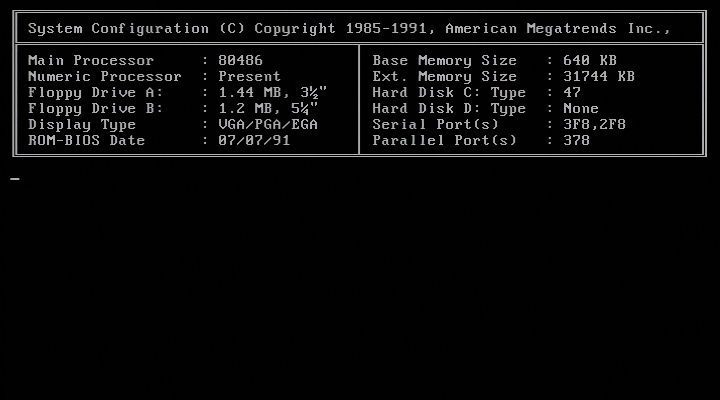
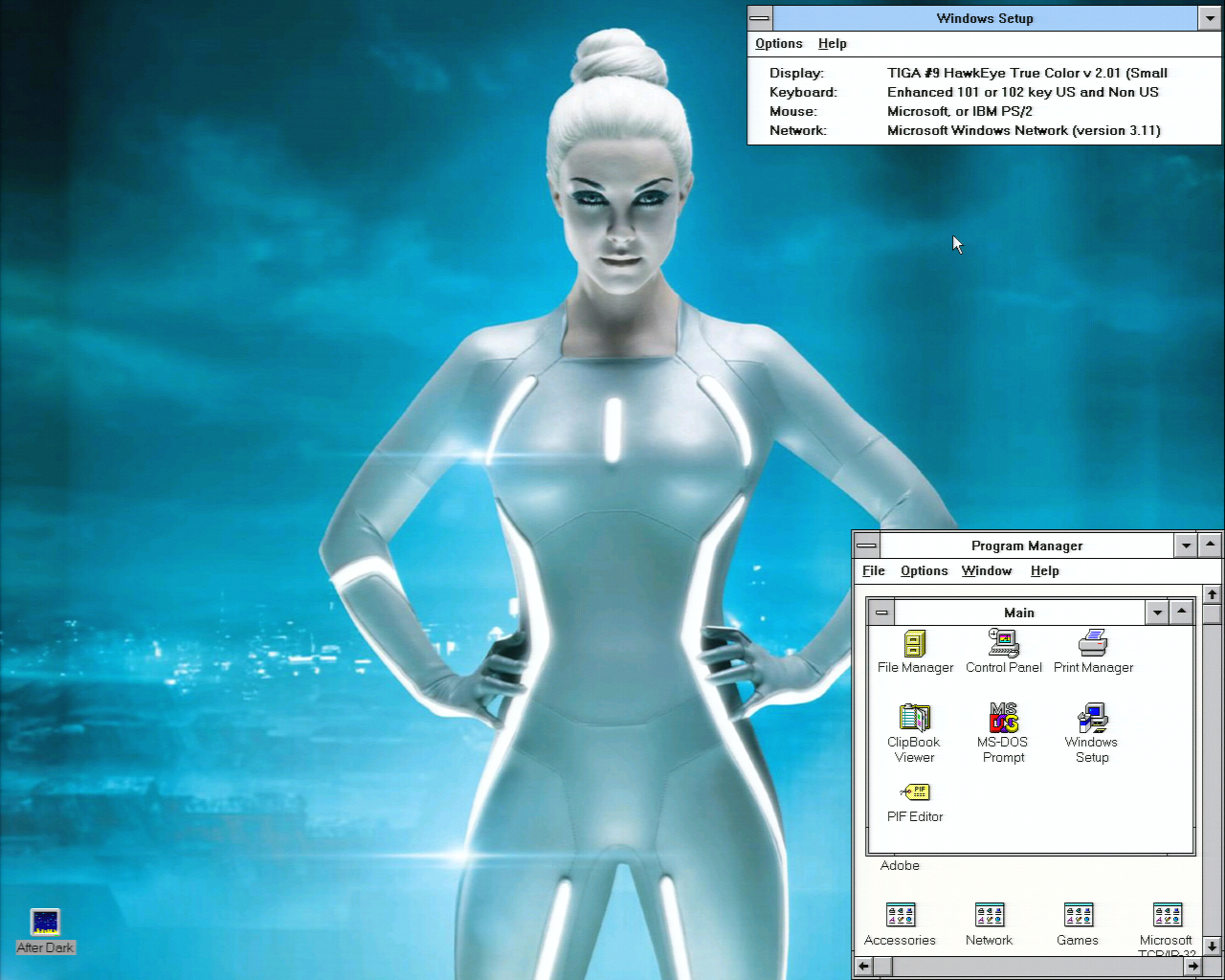
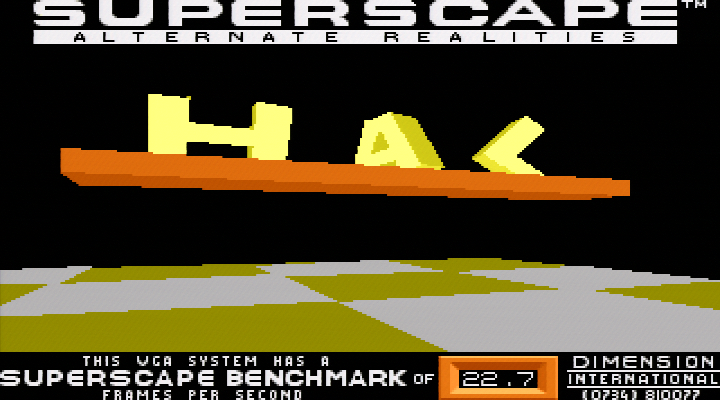
This system runs MS-DOS 6.x and Windows for Workgroups 3.11. WfW is configured to use the TIGA graphics. The card is set to 1280x1024 at 64K colors with full 2D acceleration. This is quite impressive for a 386 class system and fits with a common 17" TFT display as native resolution. In DOS the TSENG ET4000 is fast enough for the 386. The sound cards support all important standards for games, noteably also General Midi with the EWS64S custom loadable soundfont support from DOS.
| 386 system | |
| CPU | AMD 386DX-40 with i387-33 (at 40 MHz) |
| Mainboard | Soyo SY-019I with ETEQ386-8 chipset |
| RAM | 8x 4 MB SIMM 30pin |
| Graphics |
TSENG ET4000 with 1 MB and Truecolor DAC (image similar) |
| Network | 3Com Etherlink III 10 MBit/s |
| Sound |
Sound Blaster 16 ASP (DSP 4.05) with Wave Blaster CT1900. Gravis Ultrasound PnP Pro with 8 MB |
| Storage |
Multi I/O Controller Goldstar Prime 2 3.5" and 5.25" HD disk drive Quantum Fireball 1280AT Samsung SHD-30560A Sony CDU-33A double speed drive on own controller card serial/parallel ports with 16450 UART |
| Other |
Quantimet AT tower case |
This is a rock solid 386 system.
The system has a common Sound Blaster / Ultrasound combination for sound support. The GUS-PnP has full hardware acceleration games that support the standard or for tracker style musik playback. The Sound Blaster 16 covers all Creative standards and has a real Yamaha OPL3. The Wave Blaster wavetable board uses 4 MB ROM for instrument samples and the Proteus Soundengine and can be set to use General Midi sound set or MT-32 compatible sound set.
Since the BIOS got the 504 MB CHS limit I was thinking of replacing the IDE drive with a SCSI drive. On the other hand all the DOS stuff that runs on a 386 is not taking up a lot of space. So I kept it with two 504 MB HDDs and added Stacker 4.1 disk compression on the secondary drive.
The chipset has 64 kB L2-Cache that caches up to 16 MB. Though this does not hurt DOS games as there are not much DOS games that run on a 386DX-40 and require more than 16 MB. Just in case a XMS Ramdrive with the size of 16 MB can be loaded to cover the top area of memory which runs uncached. MS-DOS 6 and Win95a run fine, XTC-Player with GUS PnP support, oldschool demoscene productions. Win95 uses the whole 32 MB including the uncached top 16 MB. But there are not many useful application anyway (Total Commander, MOD4WIN, mIRC, Winamp for Midi).
| 386 system 2 | |
| CPU | AMD 386DX-40 with ULSI 3C87-40 |
| Mainboard | unidentified Ali M1429 / M1431 chipset, 128 kB cache |
| RAM | 4x 4 MB SIMM 30pin |
| Graphics |
SPEA-V7 MERCURY PRO with S3 Vision928, 4 MB VRAM, Truecolor DAC 170 MHz |
| Network | 3Com Etherlink III 10 MBit/s |
| Sound |
Aztech Sound Galaxy NX II Gravis Ultrasound MAX with 1 MB |
| Storage |
TEKRAM DC-600CF cache controller with 4 MB, EIDE support through extended Int 13h. 3.5" and 5.25" HD disk drive HDD Quantum Fireball 2110AT CD-ROM Mitsumi FX600S Costronic RTA-03C with 4x serial ports |
| Other |
Power Supply: Bestec BPS-2004-4T 200W Highscreen 386SX-16 desktop case |

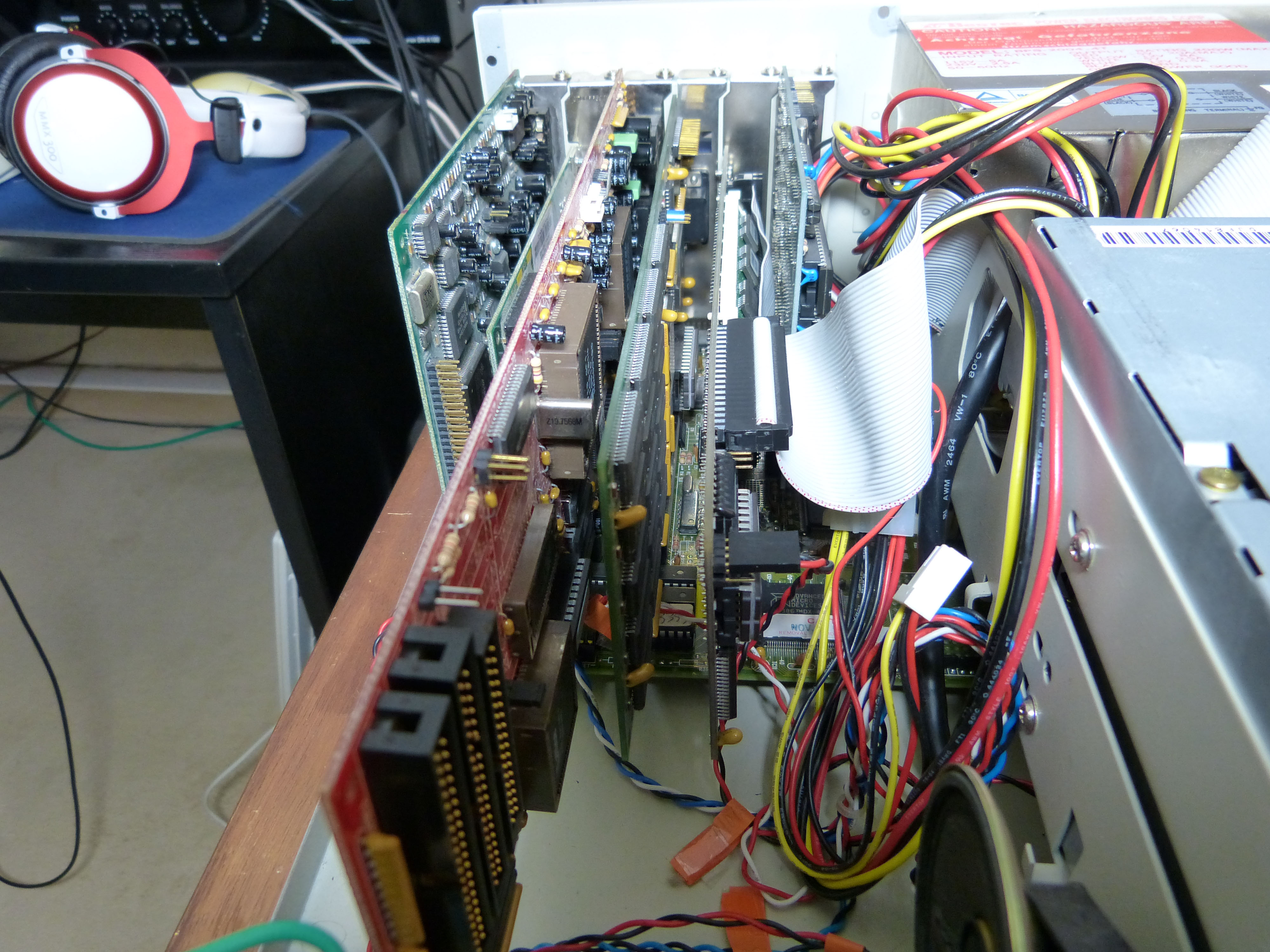



| AMD K5 system | |
| CPU | AMD K5 PR166 @ 125 MHz (1.5x83.3 MHz) |
| Mainboard |
ASUS P5A-B |
| RAM | 256 MB SDRAM |
| Graphics |
Hercules Dynamite 128/Video (TSENG ET6000) 3dfx Voodoo with passive coolers |
| Network |
Realtek RTL8139C |
| Sound |
Guillemot Maxi Sound 64 Dynamic 3D with 16 MB RAM |
| Storage |
onboard PIIX4 controller 3.5" HD disk drive HDD Quantum Fireball lct10 CD-ROM Teac CD-524EA 24x |
| Other |
Power Supply: Astec SA201-3440 Peacock desktop case |






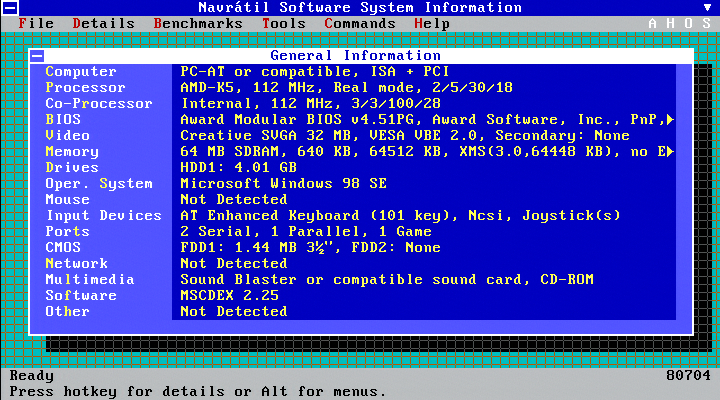
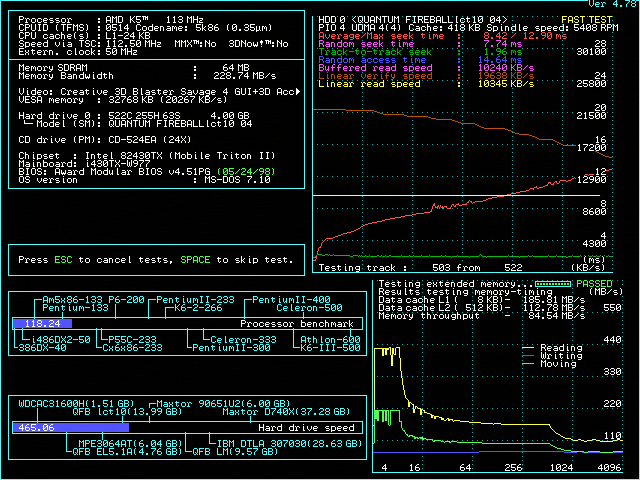
The system pictures are not up to date and still show the previous configuration. Benchmarks show that games run a faster with 83 MHz FSB compared to standard settings at 66 MHz FSB, even with lower CPU clock. The effective CPU power is somewhere between a Pentium 166 MHz and Pentium 200 MHz. The ET6000 is fast in DOS. The regular 4 MB Voodoo accelerates Descent 2, GTA, Tomb Raider a.s.o.

| AMD Slot-A Athlon system | |
| CPU | AMD Athlon 800 MHz - Thunderbird core |
| Mainboard |
Gigabyte GA7-IXE with AMD Irongate chipset |
| RAM | 512 MB SDRAM sufficient for default Win98SE |
| Graphics |
3dfx Voodoo5 5500 AGP Matrox m3D |
| Network |
Realtek RTL8139C |
| Sound |
Terratec EWS64 XL with 34 MB Yamaha DB50XG (in front panel of EWS64XL) Primax Music Sound (identical to GUS CD3) with 1 MB |
| Storage |
3.5" Newtronics D359T7 HD disk drive Transcend TS128GPSD330 128 GB EIDE SSD Pioneer A05SZ Slot-In DVD-ROM drive |
| Other |
Hauppauge WinTV 44804 D148 Power Supply: BeQuiet BQT E9-400 400W Midi tower case for slot systems (with rotated power supply) |




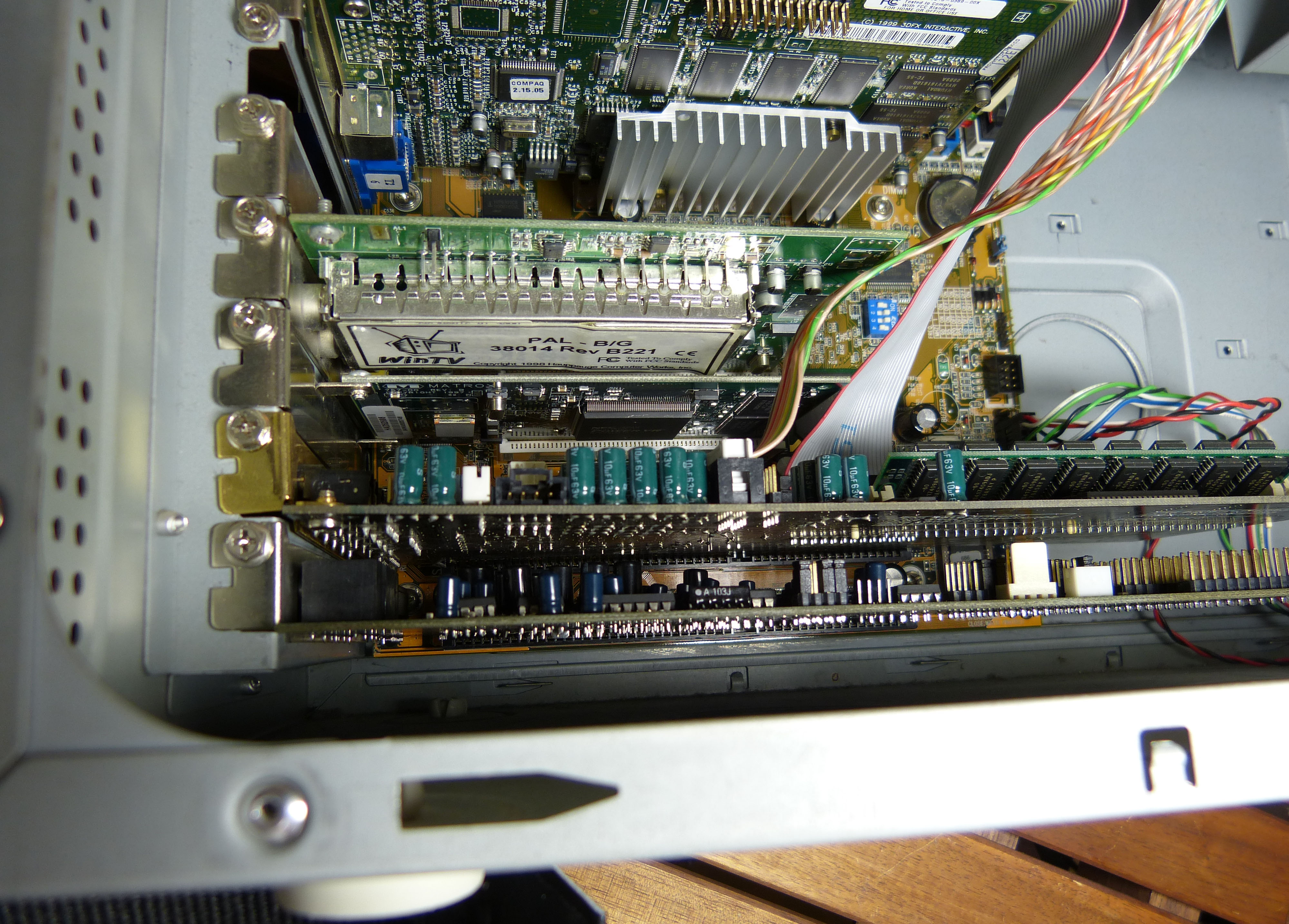
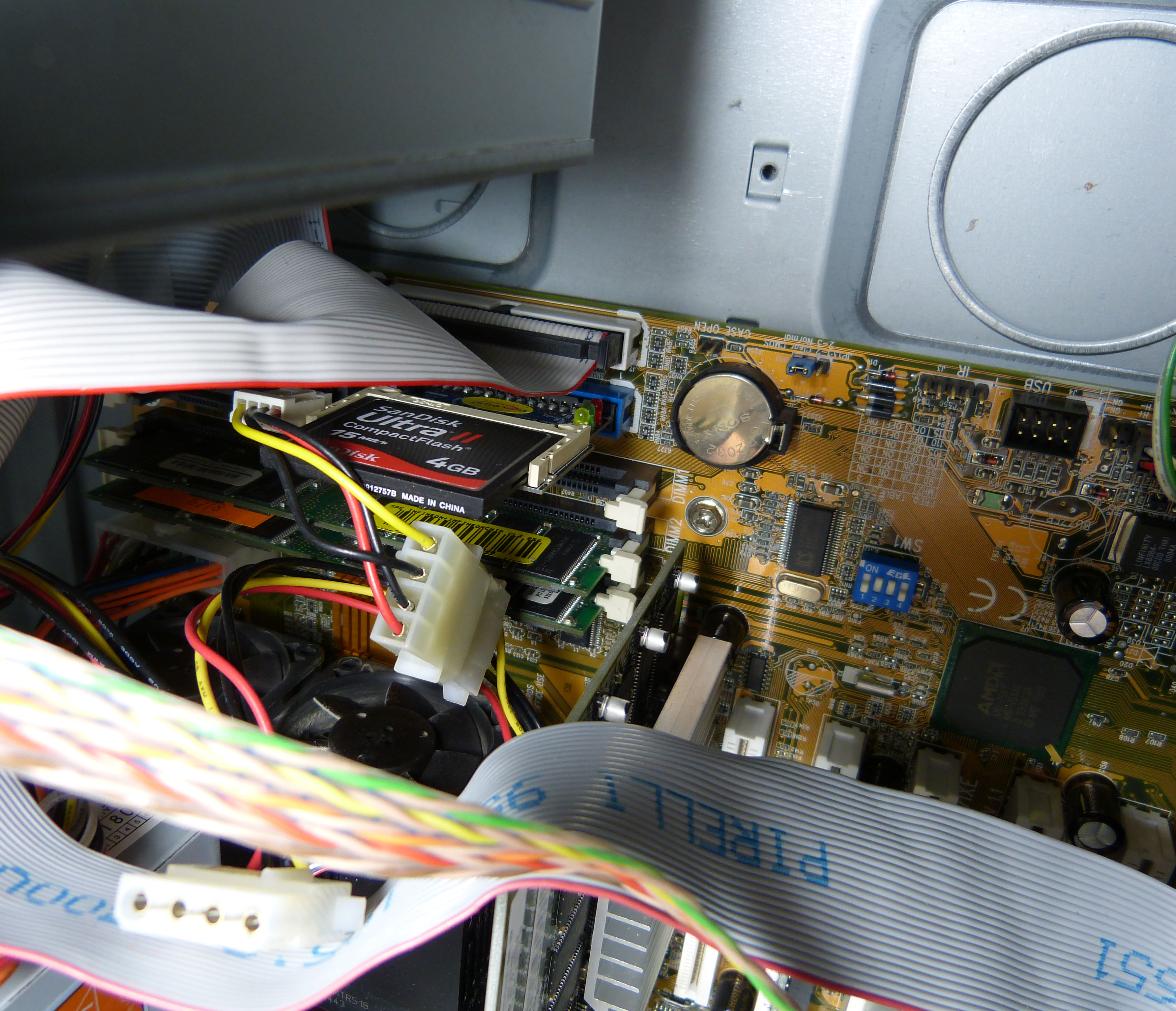



Photos are a bit outdated. This system covers DOS games that require a fast system. In Win98 the graphics cards cover D3D, Glide and SGL standards. At the same time one can choose from various wavetable options for music. The TV card is for home computer sources such as C64 as it is BT878 based which can handle 50 Hz progressive sources.
| Pentium III Slot-1 650 MHz | |
| CPU | Pentium III 650 MHz - Coppermine |
| Mainboard | HP Holmes mainboard with Intel i440ZX chipset |
| RAM | 256 MB SDRAM |
| Graphics |
onboard Matrox G200A AGP with 8 MB SDRAM 3dfx Voodoo2 SLI, 12 MB each |
| Network | 3Com Fast Ethernet TX 100 MBit/s |
| Sound |
Terratec EWS64 XL with 18 MB Roland Sound Canvas SCB-55 (in front panel of EWS64 XL) |
| Storage |
3.5" and 5.25" HD disk drive HDD Quantum Fireball lct10 4 GB CD-ROM Lite On LTN485S 48x |
| Other |
Power Supply: Astec SA202-3645 200W HP Vectra VL case |


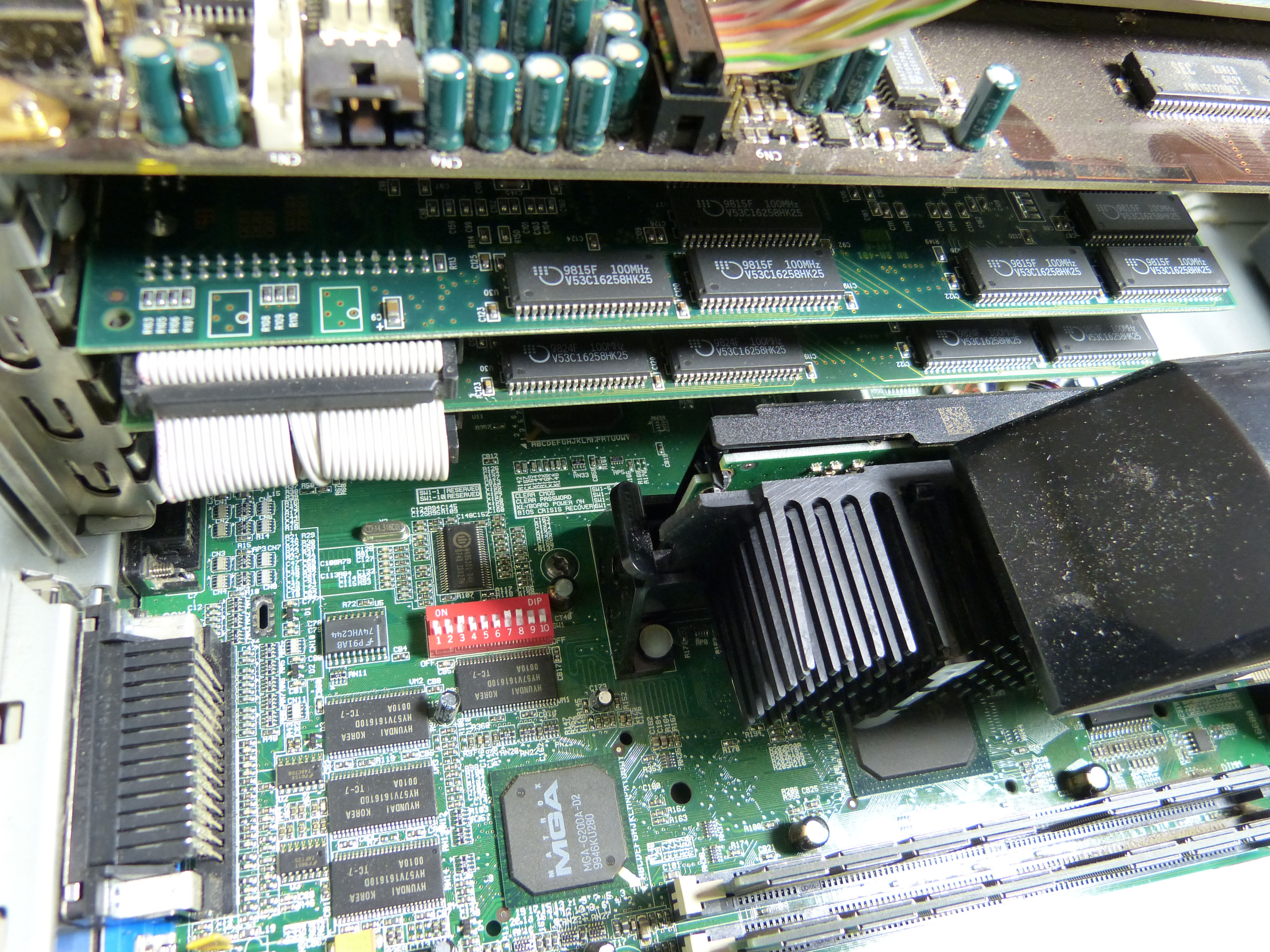

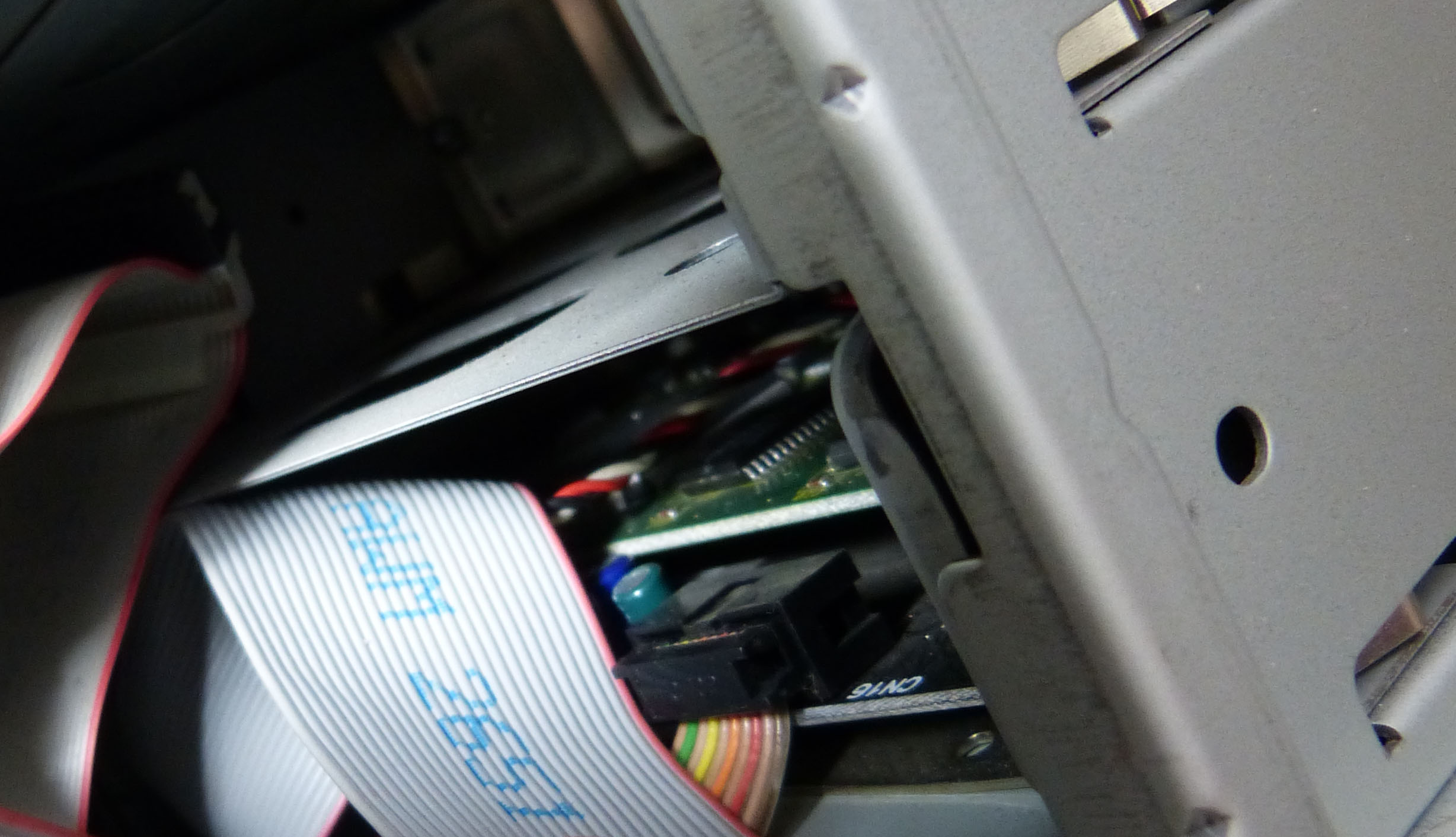


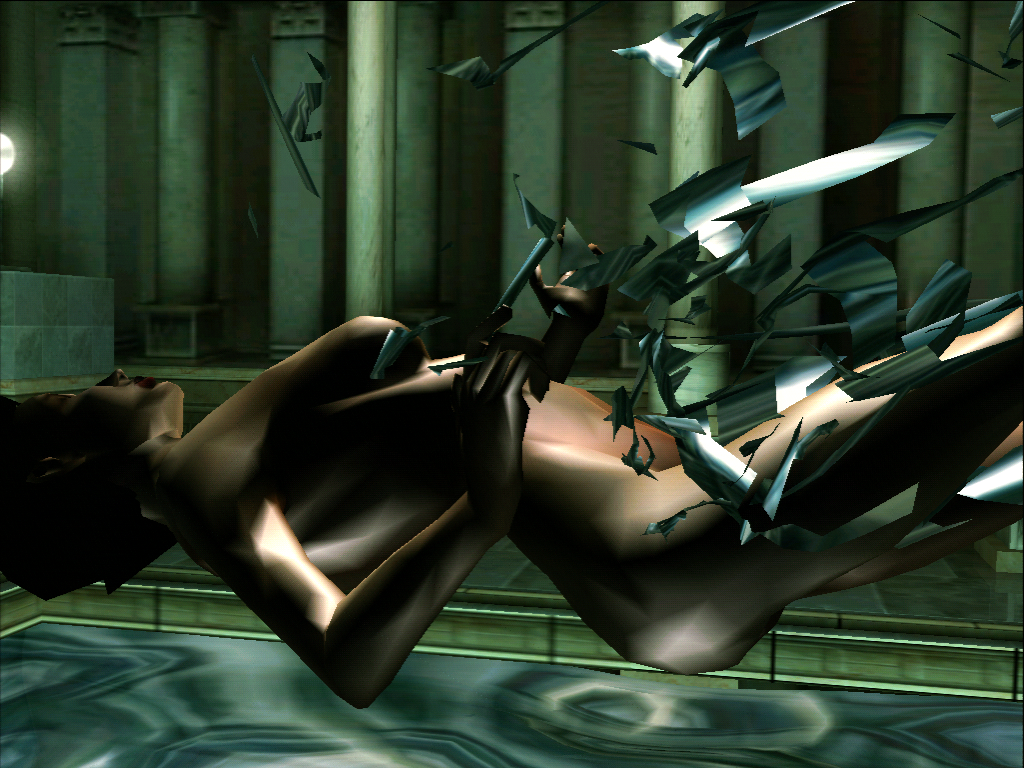
A versatile Glide system. The onboard Matrox combines well with the 3dfx cards. It is also well suited for demanding DOS games with full support for GM music.
| Pentium I 166 MMX | |
| CPU | Pentium 166 MMX |
| Mainboard | Gigabyte GA-586HX 1.51 (image shows board rev 2) with pipelined burst cache module. (512 kB). |
| RAM | 384 MB PS/2 SIMM |
| Graphics |
ELSA Victory Erazor PCI 4 MB SGRAM, Video In/Out A-Trend Helios 3D (3dfx Voodoo) |
| Network | Realtek 8139C 100 MBit/s |
| Sound |
Guillemot Maxi Sound 64 Home Studio with 4 MB ROM and 16 MB RAM Yamaha DB60XG (NEC XR385) on the Maxi Sound 64 Primax AltraSound (identical to GUS CD3) with 1 MB |
| Storage |
Intel PIIX3 Highpoint HPT370/372 dual channel EIDE controller with extended INT 13h. 3.5" and 5.25" HD disk drive HDD IBM DTLA 305040 40 GB HDD IBM DJNA 351520 15 GB DVD-ROM Pioneer DVD A04SZ |
| Other |
Power Supply: 200W AT Midi Tower 2x 5.25", 3x 3.5" case |










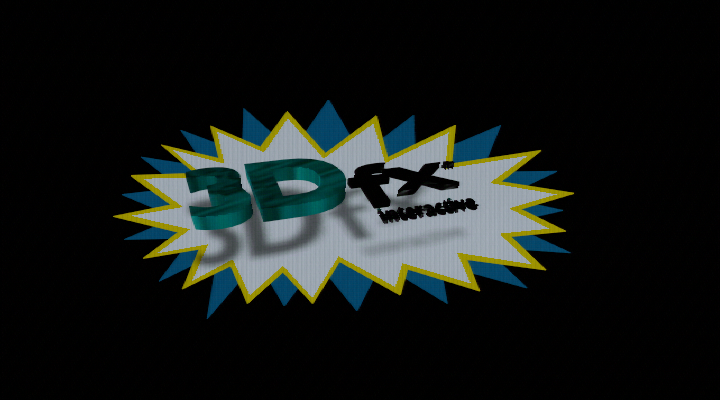


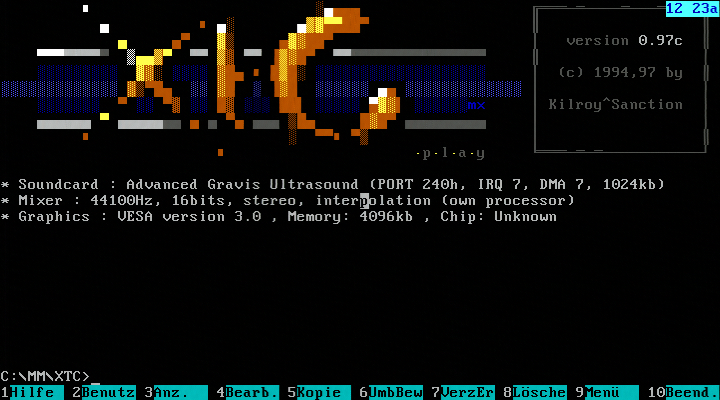
The 40 GB HDD boots DOS, the 15 GB boots Windows NT4 workstation. Both HDDs are connected to the Highpoint controller and the DVD-ROM to the onboard IDE controller. The Riva128 is fast in DOS and has full VBE3 support. The Maxi Sound has a badly placed waveblaster connector so the DB60XG is plugged a bit tilted to the pin connector, however the contact is reliable. The ROM of the Maxi Sound 64 contains the Roland Sound Canvas sampleset from Dream. It is not possible to load additional sound fonts in DOS. On Port 330 the DB60XG plays which sounds different and also supports XG standard. This computer was also setup at the Long Night of Computer Games in Leipzig.
The system runs even Firefox 2.0.23 fine (with flash disabled).
| AMD K6 233 MHz | |
| CPU | AMD K6 233 MHz (at 3.3V) |
| Mainboard | Gigabyte GA-586HX 1.55 (image shows board rev 2) with 512 kB cache. |
| RAM | 128 MB PS/2 SIMM |
| Graphics |
Innovision Mighty Banshee 16 MB SDRAM |
| Network | Realtek 8139C 100 MBit/s |
| Sound |
Terratec EWS64 XL with 18 MB Roland Sound Canvas SCB-55 (in front panel of EWS64 XL) Gravis Ultrasound 3.4 with 1 MB |
| Storage |
Intel PIIX3 Adaptec AHA-2940UW 3.5" and 5.25" HD disk drive HDD SanDisk Ultra II CompactFlash 4 GB CD-ROM Plextor PX-40TS UltraPlex |
| Other |
Power Supply: MACASE 250W AT Midi Tower 2x 5.25", 3x 3.5" case / Starchip Computer Profiline |



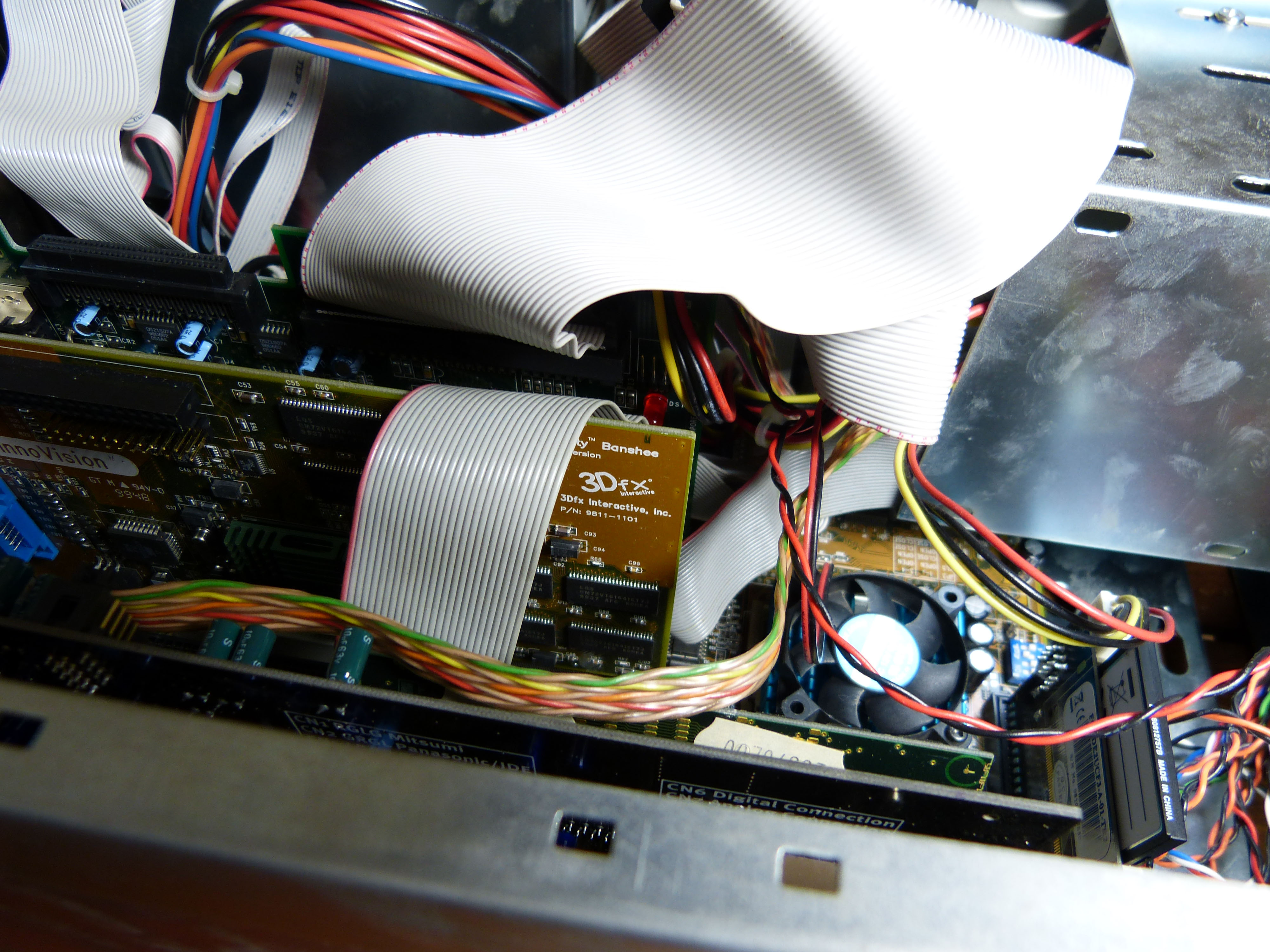






Rather silent PC for old DOS games and scene demos. It features all important sound card standards of this time. The Banshee has the new 2D core from 3dfx and is one of the fastest 2D-cards (in VESA modes) in DOS. The Pentium systems with the HX chipset are quite matured. It has fast PCI local bus, 2 channel IDE onboard and usually 3 or more ISA-Slots and some even have USB. So the hardware is between the old DOS era and the Windows era. MS-DOS 6 and Win98SE run as OS.
| AMD K6-2+ 600 MHz | |
| CPU | AMD K6-2+ 570 at 600 MHz (6x 100 MHz) |
| Mainboard | Asus P5A Rev. 1.04 |
| RAM | 384 MB SDRAM |
| Graphics |
ELSA Gloria III / NVidia Quadro2 Pro (Geforce2 Pro) 64 MB DDR-SDRAM 3dfx Voodoo2 SLI 12 MB each from Orbit 3D |
| Network | Realtek 8139C 100 MBit/s |
| Sound |
Terratec Base 1 with Radio Module Active Radio Module Dreamblaster X2 Wavetable |
| Storage |
Intel PIIX3 Adaptec AHA-2940UW 3.5" and 5.25" HD disk drive HDD Quantum Atlas 10K2 10000rpm, 18 GB DVD-ROM NEC DVD-RW ND2100-AD |
| Other |
Power Supply: 350W Raptoxx RT-350W ATX Midi Tower 2x 5.25", 3x 3.5" case from ??? |



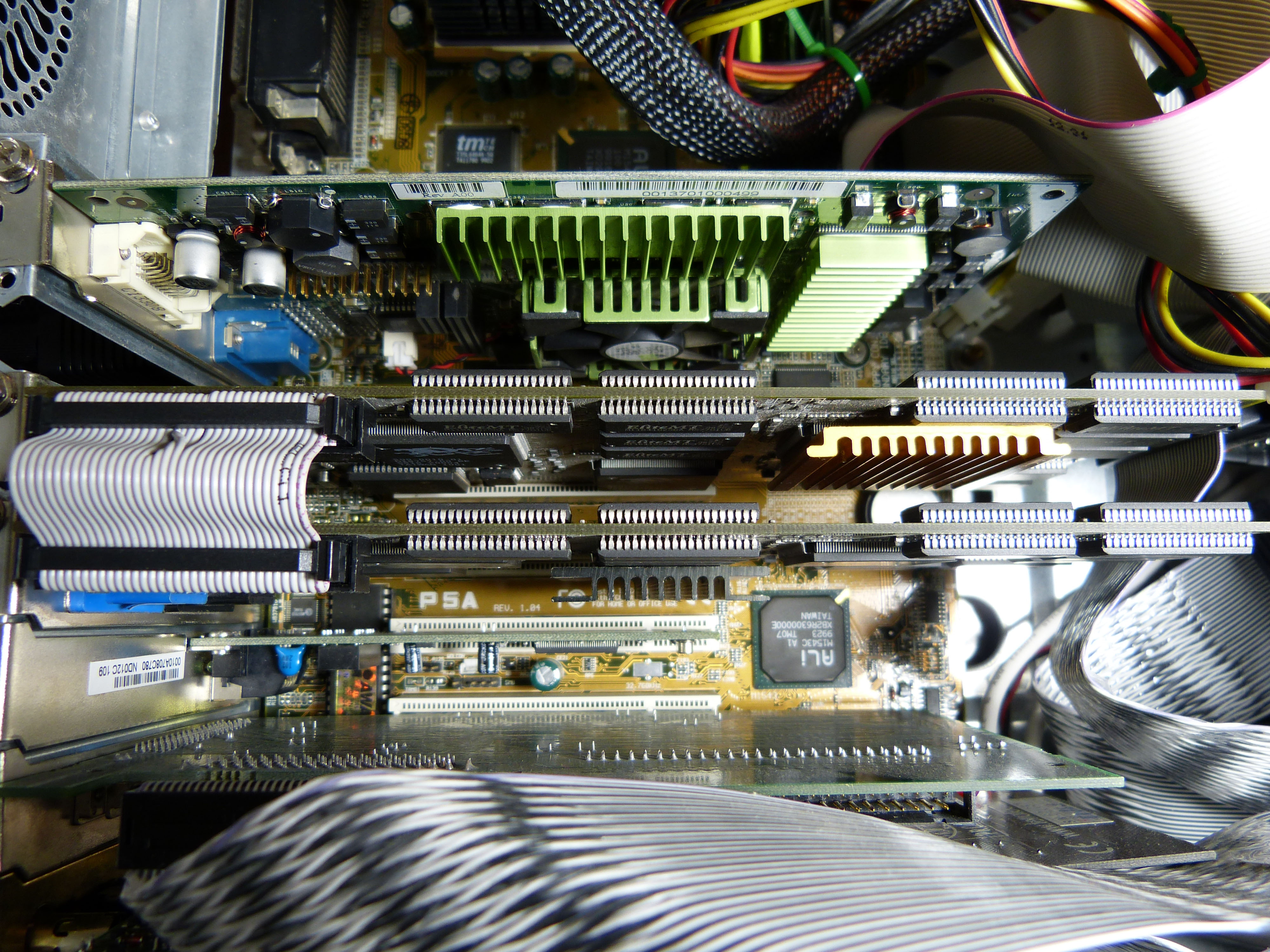




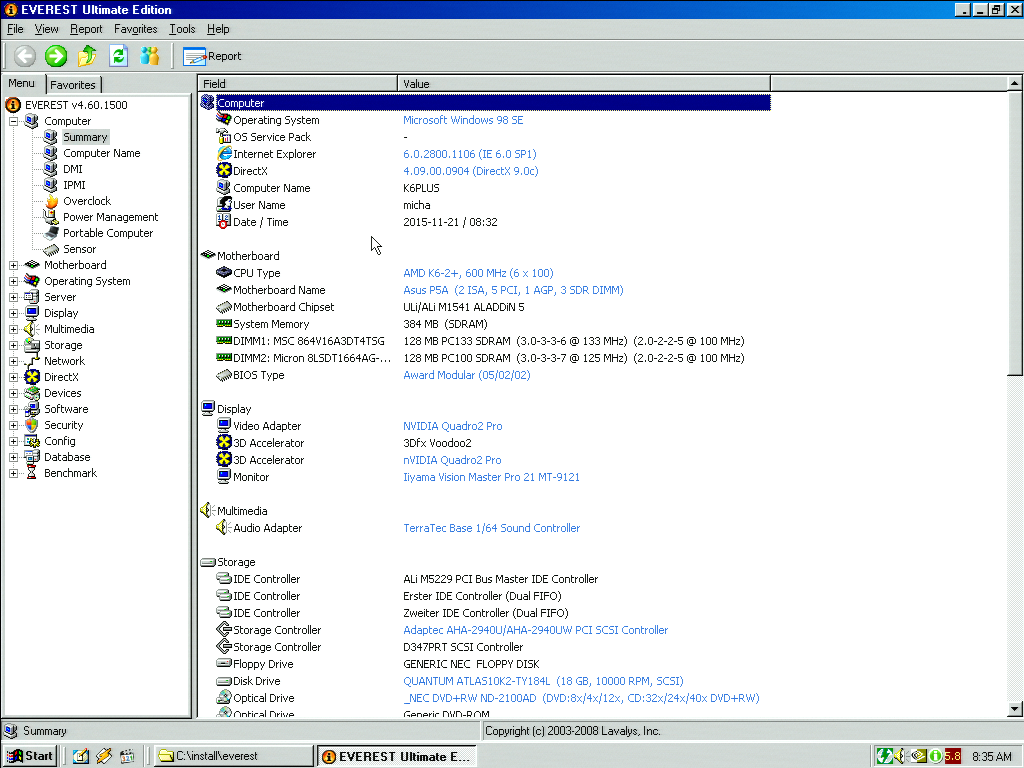


On this system MS-DOS and WIN98SE runs. The graphics solution is very fast for the CPU and a single Voodoo2 would not be slower. However it could not run 1024x768 resolution. The Quadro2 has also DVI Out. While the card do not support dual view the digital output is nice for lossless captures. Nonetheless the screenshots from the pictures are analog routed through the Voodoo2. The system shows no AGP instabilities at full 2x speed. The ASUS P5A has an early ACPI BIOS that maps all PCI IRQs to ISA. So in Win98SE IRQ9 is always occupied by SCI IRQ for ACPI and the required IRQ for the Base-1 MPU-401 interface has to be moved elsewhere. So I disabled in the Ali IDE driver the secondary IDE channel in the device manager which is not used in the system. This frees IRQ 15 where I could move the MPU-401 to. USB is disable din the BIOS as it would take another IRQ.
| 486DX2-66 PCI system | |
| CPU | Intel 486DX2-66 with write-back support (P24D) |
| Mainboard | Elitegroup ECS-UM8810PAIO Rev.2.1 with 256 kB cache |
| RAM | 128 MB PS/2 SIMMs |
| Graphics |
ELSA Winner 2000 Pro PCI 8 8 MB VRAM, 250 MHz DAC |
| Network | 3Com Etherlink III 10 MBit/s |
| Sound |
Terratec EWS64 XL with 34 MB Gravis Ultrasound PnP Pro with 8 MB |
| Storage |
3.5" and 5.25" HD disk drive HDD Maxtor 7546 AT DVD-ROM LiteOn SOHD-167T |
| Other |
AT Power Supply ATX Midi Tower from Multitask with internal change to AT form factor |










On this computer MS-DOS 6.22 and Windows for Workgroups 3.11 runs. The CPU supports write-back but this is in benchmarks and games slightly slower due to the increased cache latency for writes to main memory, so I use write through by default. The switch at the front was bent at a transport. The image quality of the graphics card is very good as it has a 250 MHz RAM DAC. The EWS64XL and GUS is very versatile for DOS games.
| 486DX2-66 VLB system | |
| CPU | Intel 486DX2-66 (P24) |
| Mainboard | Elitegroup ECS-UM486V-AIO(DIP) Rev.2.0 with 256 kB cache |
| RAM | 8x 1 MB SIMM |
| Graphics |
Diamond Stealth 64 Video VRAM VLB 4 MB VRAM Diamond MVP-2000 MPEG-1 Video Extension 2 MB VRAM |
| Network | 3Com Etherlink III 10 MBit/s |
| Sound |
Terratec Maestro 3296 Gravis Ultrasound 2.4 with 1 MB |
| Storage |
Adaptec AHA-1542C (page shows 1542B) 3.5" and 5.25" HD disk drive HDD Seagate ST410800N Elite9 series 9 GB CD-ROM Plextor PX-40TS UltraPlex |
| Other |
ATX Power Supply with AT adapter AT tower case from Peacock |
| Compaq Presario CDS-520 | |
| CPU | AMD 486SX2-66 |
| Mainboard | Compaq Cyclops board, no L2 cache |
| RAM | 52 MB PS/2 SIMM |
| Graphics |
VLB Cirrus Logic GD5424 with 512 kB BitBLT support. |
| Network | 3Com Etherlink III 10 MBit/s |
| Sound |
ESS 688 (onboard) Gravis Utrasound ACE with 1 MB |
| Storage |
onboard controller 3.5" HD disk drive HDD Seagate ST51080A Medialist 1080sl 1 GB CD-ROM Mitsumi CRMC-FXN01DE double speed ISA Modem card |
| Other |
all integrated case |

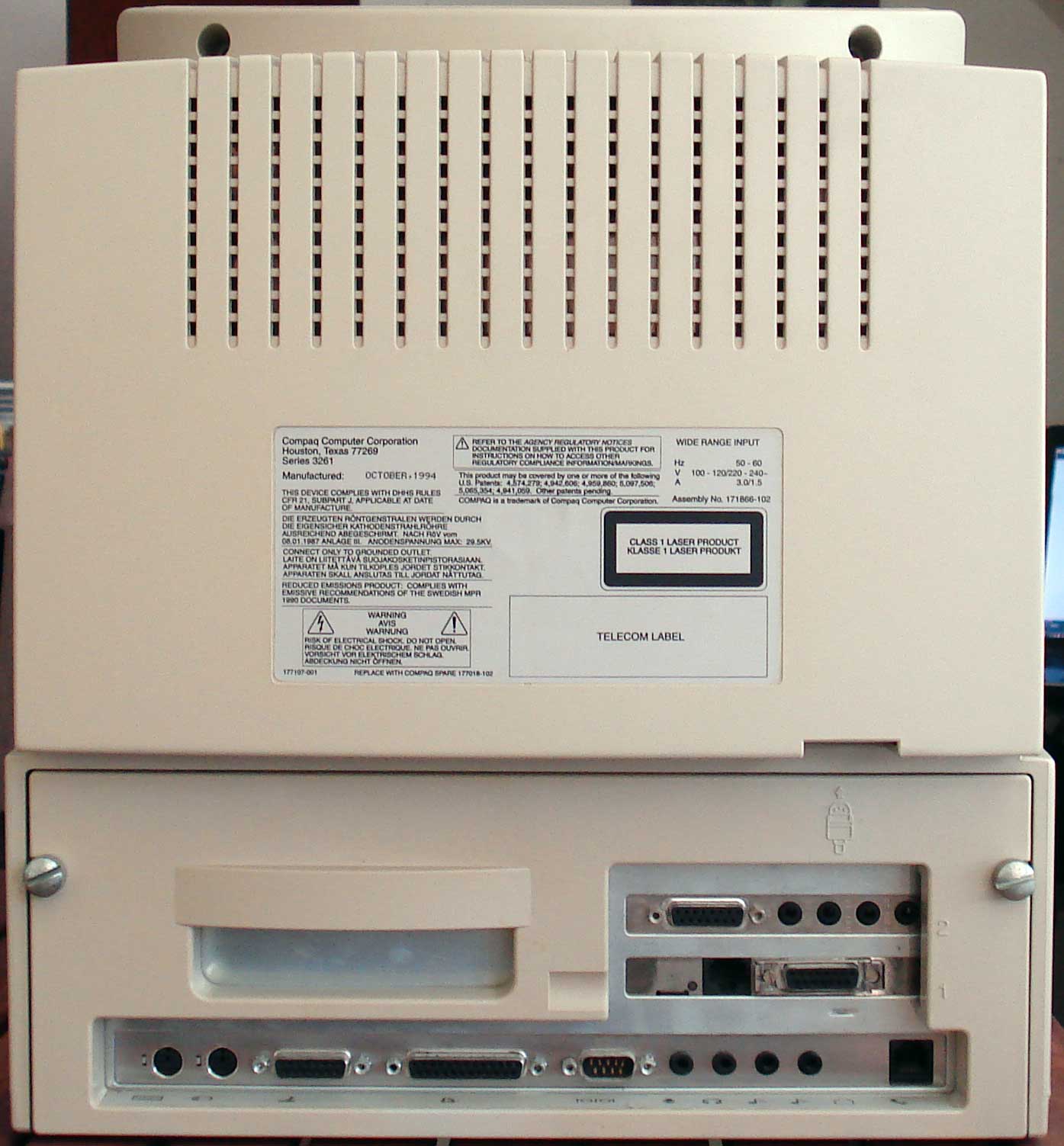
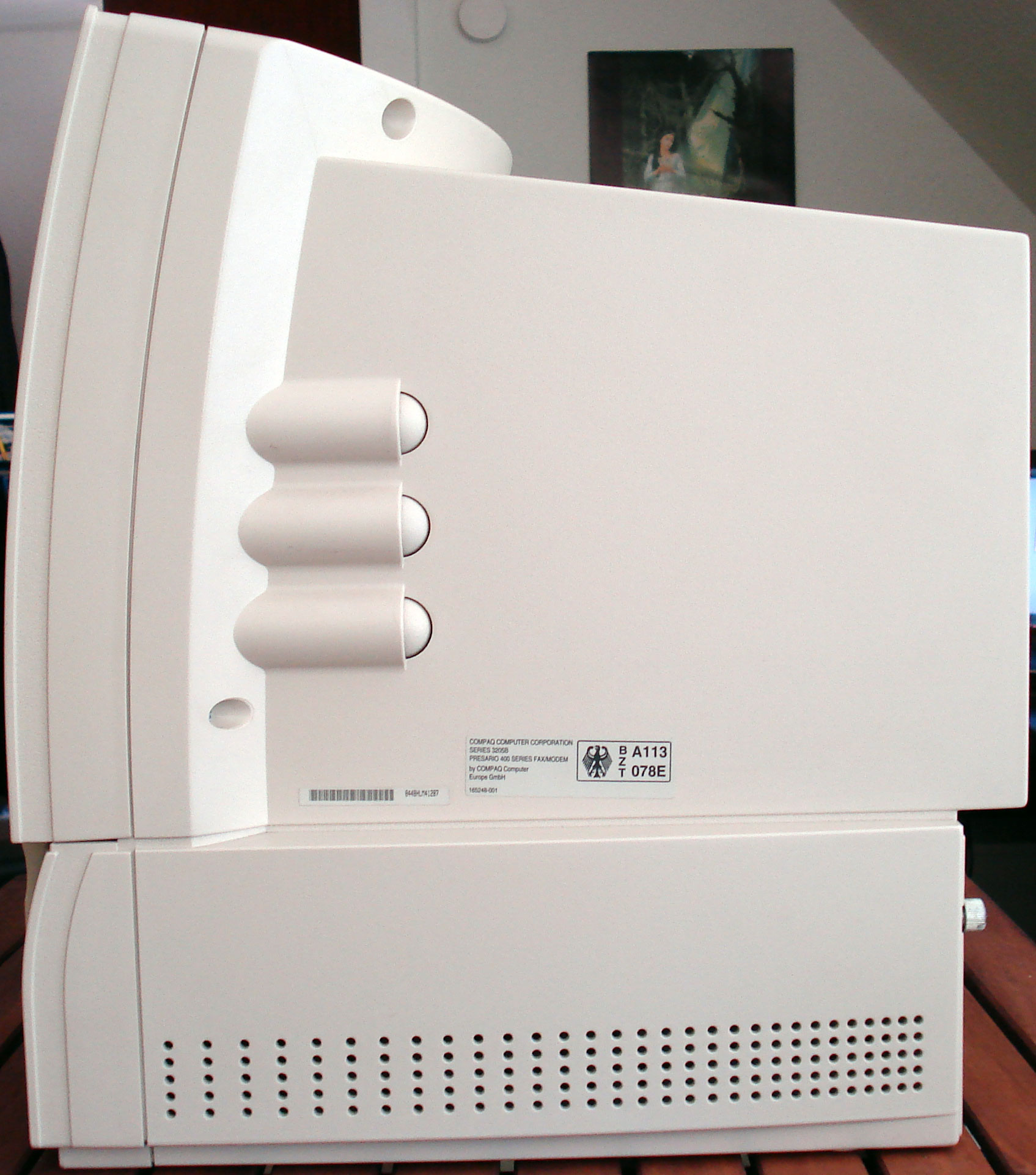
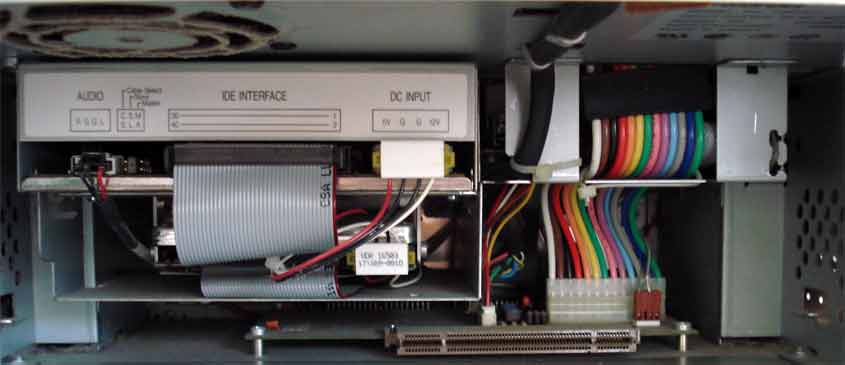
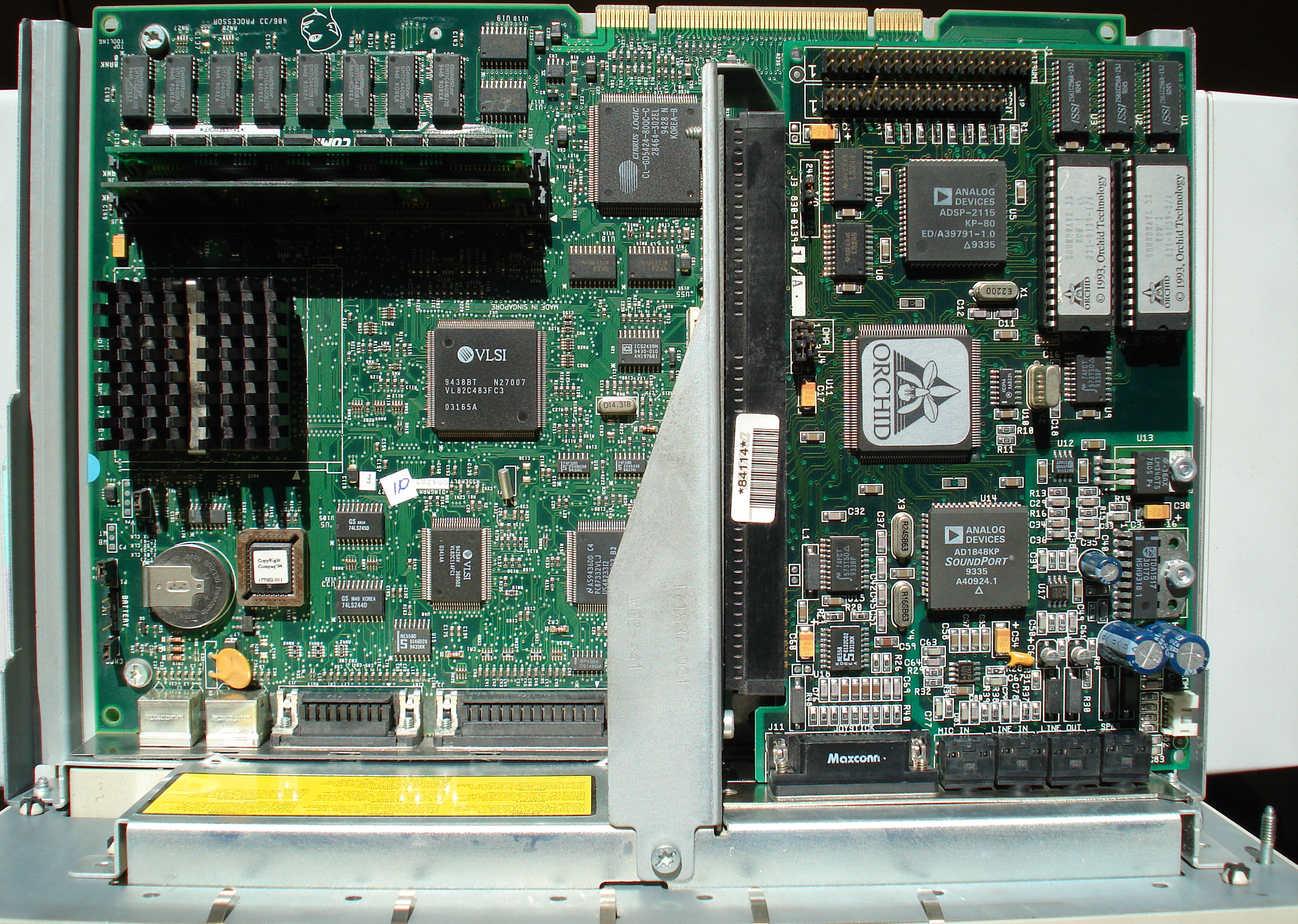
The Compaq Presario CDS-520 is a all-in-one system and looks like a big Mac classic. It has an integrated 14" CRT screen and speakers. It runs MS-DOS 6 Compaq edition / Window for Workgroups 3.11. The 486SX2-66 runs Descent very well and appears to be in integer benchmarks just 10% slower than a self-built 486DX2-66 (Norton Utilities 7 Sysinfo). Turbo and cache can be switched by software with MODE.COM.
The computer has been donated to Haus der Computerspiele.
| Commodore PC-1 | |
| CPU | Siemens 8088 at 4.77 MHz |
| Mainboard | Commodore Custom Made Mainboard |
| RAM | 512 kB DRAM |
| Graphics |
Motorola 6845 CRT controller for text mode and Paradise PVC2
for CGA / Plantronics? with 32 kB DRAM |
| Network | n/a |
| Sound |
PC Speaker |
| Storage |
no HDD 5.25" DD disk drive 160 kB 3.5" DD Amiga drive can be plugged as external drive (720 kB) |
| Other |
small desktop case |
The power supply was defect so I used an AT power supply (which can be plugged in a special orientation to the onboard power connector). Of course a regular AT power supply does not fit into the case.
